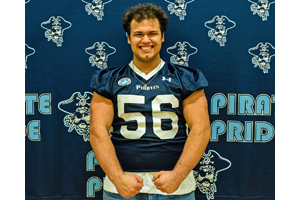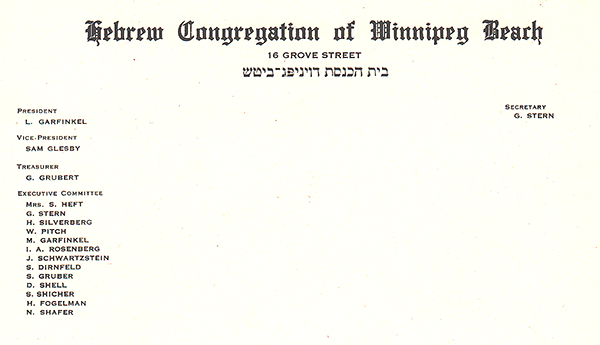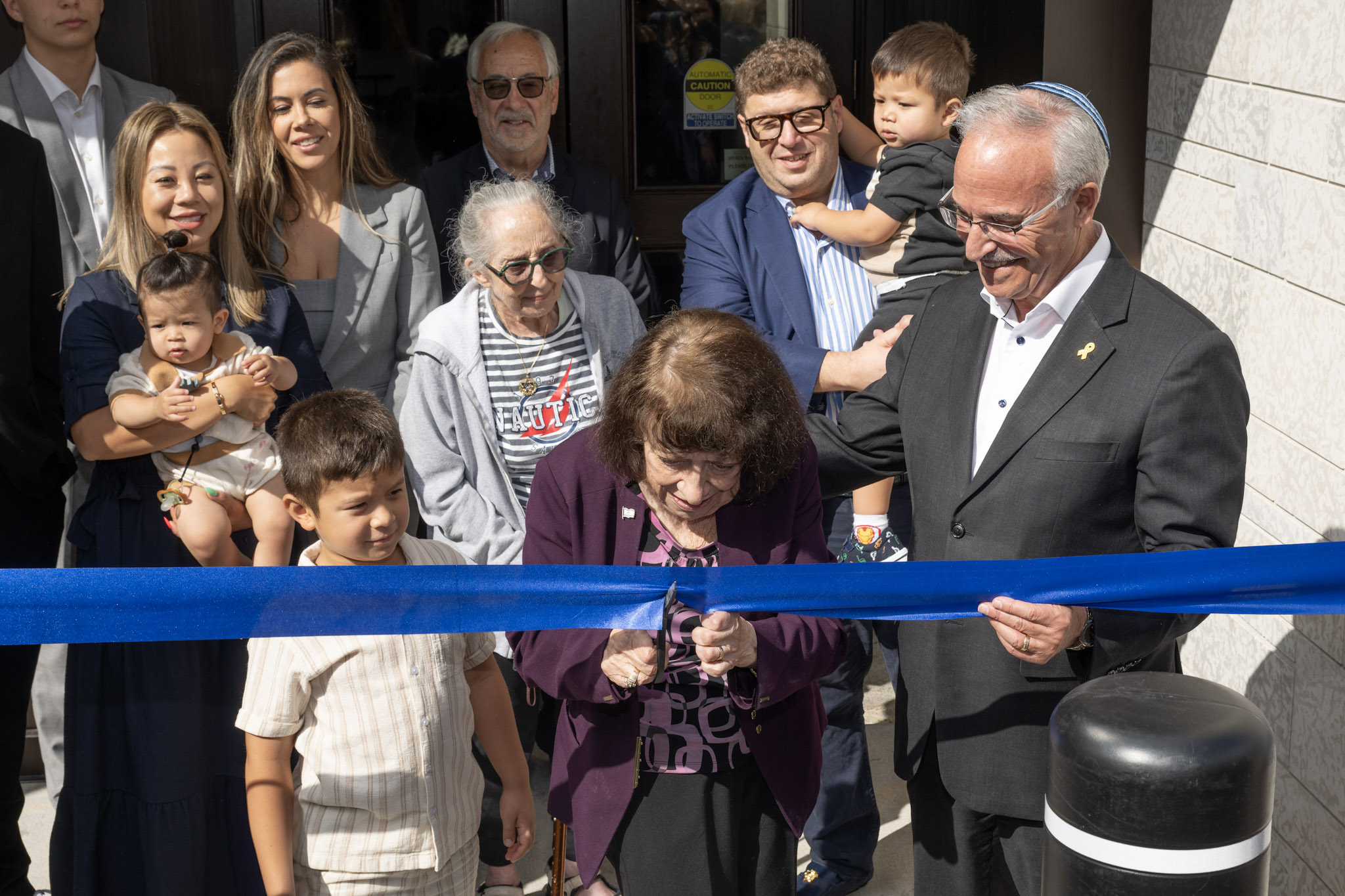Local News
Nathaniel Lisak is the complete package: brawn and brain

By BERNIE BELLAN Recently we published a story about nominees for Jewish Athlete of the Year. One of those nominees is Nathaniel Lisak, an outstanding football player from Grant Park High School. The picture we ran of Nathaniel, however, was not Nathaniel. We apologize for that error. A correct picture of Nathaniel appears with this story.
We admit though, that impressive a background as Nathaniel has as an athlete, of all the six nominees for Jewish Athlete of the Year, Nathaniel is the only one about whom we hadn’t published a story in this paper – until now.
We were contacted by Nathaniel’s father, Roman, after that issue came out. Roman informed us that the picture we had of Nathaniel was not Nathaniel. I responded contritely, apologizing as best I could, and asked Roman whether Nathaniel might be amenable to being interviewed so that we could do a fuller account of his accomplishments. In short order Nathaniel texted me, saying that he’d be glad to talk about his football career.
When we connected later that day I asked Nathaniel about his family’s background. Nathaniel explained that his parents, Roman and Maria, came to Manitoba from Israel in 2004. They both had originally come from Ukraine, he noted. Nathaniel also has a sister, Priel, who is six years older than him and who was born in Israel.
Upon arriving here Roman began working for Manitoba Hydro in Gillam as a Certified Engineering Technologist, Nathaniel said – and that was where he was born and lived until he was nine. In 2014 the family moved to Winnipeg when his father was offered a job in Winnipeg. (His mother Marina, by the way, works in the Rady JCC day care.)
Nathaniel began attending Brock Corydon School when the family moved to Winnipeg – in the English program. I asked him whether he was “a big kid” back then, given how big he is now.
“No,” he answered, “I was average as a kid.”
But somewhere between Grade Six and Grade Nine, Nathaniel said, he began to grow…and grow. In those three short years, he told me, he grew an astounding 11 inches – going from 5’ 3” to 6’ 2”, and gained an impressive 100 pounds. (If you look at his picture you’ll see that those 100 pounds turned mostly into muscle.)
It wasn’t until he was in Grade 8 that Nathaniel even strapped on pads and began playing tackle football, he noted. Prior to that the sport he played the most was basketball. He had also become a shot putter as he started to grow.
Now, if you consider how quickly Nathaniel grew, you might wonder how he adjusted to that sudden growth spurt. He said that it wasn’t easy and that at times it was quite uncomfortable given how rapidly he grew in height and added weight but, given his success on the football field, it’s clear that he’s adapted himself to his increased size with flying colours.
As the blurb that was sent to us by the Rady JCC in describing the nominees for Jewish Athlete of the Year noted, “Lisak excelled at the defensive tackle position for the Grant Park Pirates Football team this past season. After helping his team compile a 5-1 regular season record and a spot in the championship final, Lisak was honoured with numerous personal accolades. He was named to the CFC (Canada Football Chat) All-Canadian First Team and was the recipient of the Winnipeg High School Football League (WHSFL) Kas Vidruk Lineman of the Year. At the school level he was named the Grant Park Football Most Valuable Player and was awarded the school’s Football Captain Award. He was runner up for the 2021 WHSFL Defensive MVP & 2021 Harry Hood Citizenship Award. In grade 10 he became a known player in Manitoba and was named a Nationally ranked top 100 player in Canada, being a top 5 Manitoban and top three defensive tackle in the 2022 graduating class.”
I wondered whether there are any particular professional football players that Nathaniel has tried to emulate since he started playing football?
“I remember watching J.J. Watt (an extremely mobile, although quite large defensive end) play,” Nathaniel observed. “I was amazed how someone that big could move that fast.”
Yet Nathaniel now says that his role model is Aaron Donald, the huge defensive tackle for the Super Bowl champion Los Angeles Rams, who is legendary for his quickness despite weighing 280 pounds. (Donald, by the way, stands 6’1”, so in terms of comparison, he and Nathaniel are roughly the same height and weight.)
As the blurb about Nathaniel in our last edition also noted, he received numerous scholarship offers from universities across Canada. He said though that he’s chosen to go to McMaster University in Hamilton. Not only does McMaster have a great football program, it also has an excellent business school. Nathaniel told me that his plan is to enter that school. Given that he’s also been an honour roll student at Grant Park and that his favourite subject is math, he told me, it should be a good fit.
In addition to his studies and his athletic pursuits, for the past year Nathaniel has been serving as the Regional B’nai Brith Youth Organization president. (He’s a member of “Alaphim,” he noted.) His term will end this June.
Quite the package: An outstanding athlete, a terrific student, and an active member of BBYO. He was also quite forgiving of my running the wrong picture of him. On the other hand I interviewed Nathaniel over the phone. I’m not sure I would have been prepared if it turned out that he wanted to practice a bull rush on me to retaliate for my faux pas.
Local News
Thank you to the community from the Chesed Shel Emes

We’re delighted to share a major milestone in our Capital Campaign, “Building on our Tradition.” Launched in November 2018, this campaign aimed to replace our outdated facility with a modern space tailored to our unique needs. Our new building is designed with ritual at its core, featuring ample preparation space, Shomer space, and storage, creating a warm and welcoming environment for our community during times of need.
We’re grateful to the nearly 1,000 generous donors who contributed over $4 million towards our new facility. A $750,000 mortgage will be retired in November 2025, completing this monumental project in just seven years.
We’re also thrilled to announce that our Chesed Shel Emes Endowment Fund has grown tenfold, from $15,000 to $150,000, thanks to you, the Jewish Foundation of Manitoba’s FundMatch program, and Million Dollar Match initiative in 2024. Our fund helps ensure that everyone can have a dignified Jewish funeral regardless of financial need.
As we look to the future, our goal remains to ensure the Chevra Kadisha continues to serve our community for generations to come. Our focus now shifts to replenishing our savings account and growing our JFM Endowment fund.
We’re deeply grateful for your support over the past several years.
It’s our privilege to serve our community with care and compassion.
With sincere appreciation,
Campaign cabinet: Hillel Kravetsky, Gerry Pritchard, Stuart Pudavick,
Jack Solomon, and Rena Boroditsky
Murray S. Greenfield, President
Local News
Winnipeg Beach Synagogue about to celebrate 75th anniversary

By BERNIE BELLAN (July 13) In 1950 a group of cottage owners at Winnipeg Beach took it upon themselves to relocate a one-room schoolhouse that was in the Beausejour area to Winnipeg Beach where it became the beach synagogue at the corner of Hazel and Grove.
There it stayed until 1998 when it was moved to its current location at Camp Massad.
On August 2nd members of the synagogue will be holding a 75th anniversary celebration.

As part of the celebration anyone who is a descendant or relative of any of the original members of the first executive committee (as seen in the photo here) is invited to attend the synagogue that morning.
If you are a relative please contact Abe Borzykowski at wpgbeachshule@shaw.ca or aborzykowski@shaw.ca to let Abe know you might be attending or for more information about the 75th anniversary celebration.
We will soon be publishing a story about the history of the beach synagogue, which is something I’ve been writing about for over 25 years.
Local News
Vickar Family cuts ribbon on new Tova Vickar and Family Childcare Centre

By MYRON LOVE In the words of Larry Vickar, the Shaarey Zedek’s successful Dor V’ Dor Campaign “is not only a renewal of the synagogue but truly a renewal movement of Jewish life in our community.”An integral part of that renewal movement was the creation of a daycare centre within the expanded synagogue. On Monday, June 23, Larry and Tova Vickar cut the ribbon, thereby officially opening the Tova Vickar and Family Childcare Centre in the presence of 100 of their family members, friends and other supporters of the project.
The short program preceding the morning ribbon-cutting began with a continental breakfast followed by a welcome by both Fanny Levy, Shaarey Zedek’s Board President, and Executive Director Dr. Rena Secter Elbaze. In Elbaze’s remarks, she noted that Larry and Tova wanted their family (including son Stephen and family, who flew in from Florida) and friends at the event to celebrate the opening of the Tova Vickar and Family Childcare Centre, “not because of the accolades, but because, as Larry put it, he hopes that their investment in the congregation will inspire others to do the same.”
“When Larry and I spoke about what this gift meant to him and the message he wanted people to take away,” she continued, “I couldn’t help but connect it to the teachings of Reb Zalman Schachter-Shalomi whose book – Age-ing to Sage-ing – changes the whole way we look at the concept of ageing and basing it on our ancestral teachings.”
She explained that his concept of “Sage-ing” is based on three key ideas – Discover your meaning and purpose; accept our mortality and think about the legacy you want to leave.
“Larry spoke about these exact concepts when we met,” she said.
Elbaze also noted the presence of Shaarey Zedek’s newly-arrived senior Rabbi Carnie Rose, former Rabbi Alan Green, and area MLAs Mike Moroz and Carla Compton.
Larry Vickar expressed his great appreciation for all those in attendance. “Tova and I are deeply moved to stand here with you today for this important milestone in our community”, he said. “We are grateful to be surrounded by all of you, the people we care about, our family and friends… you who have touched our lives and played some part in our journey.”
